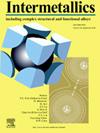Design, formability, and strengthening mechanism of CoCrFeNiTix high-entropy alloys fabricated using laser directed energy deposition
IF 4.3
2区 材料科学
Q2 CHEMISTRY, PHYSICAL
引用次数: 0
Abstract
A method combining theoretical calculations, phase diagram simulations, and experimental validation was used to strengthen the design of the CoCrFeNi high-entropy alloy (HEA). The strengthening effect of the designed alloy was confirmed through hardness simulations and experimental validation. CoCrFeNiTix (x: 0.3–1.0) HEAs were prepared using laser directed energy deposition (LDED) technology, and the influence of Ti elements on the microstructure and strengthening effect of CoCrFeNi HEA was investigated. Through thermodynamic parameter calculations and JMatPro software simulations, it was revealed that CoCrFeNiTix HEAs tend to form second phases, with the FCC phase as the main phase and the presence of BCC, Laves, η, σ, and γ′ phases, significantly enhancing the alloy's strengthening effect. As the Ti content increases, the strengthening effect gradually increases. However, when x > 0.7, the LDED CoCrFeNiTix HEAs tends to crack. The addition of Ti elements promotes the microstructure transition from cellular equiaxed grains to dendritic crystals and increases the microhardness of the HEAs. The average microhardness of CoCrFeNiTi0.3, CoCrFeNiTi0.7, and CoCrFeNiTi1.0 HEAs deposition layers are approximately 328 HV, 506 HV, and 660 HV, respectively, with simulated hardness values very close to the experimental results. Through the calculation and analysis of the strengthening mechanism, it was determined that second-phase strengthening is the main strengthening mechanism of CoCrFeNiTix HEAs. To meet the strengthening and remanufacturing needs of EH36 steel, while also considering hardness, wear resistance, corrosion resistance, and formability requirements, the maximum atomic ratio of Ti elements in CoCrFeNiTix HEAs was determined to be x ≤ 0.7. This design approach not only applies to the current work but also provides a new strategy for the subsequent design of HEAs with customized microstructures and properties.
求助全文
约1分钟内获得全文
求助全文
来源期刊

Intermetallics
工程技术-材料科学:综合
CiteScore
7.80
自引率
9.10%
发文量
291
审稿时长
37 days
期刊介绍:
This journal is a platform for publishing innovative research and overviews for advancing our understanding of the structure, property, and functionality of complex metallic alloys, including intermetallics, metallic glasses, and high entropy alloys.
The journal reports the science and engineering of metallic materials in the following aspects:
Theories and experiments which address the relationship between property and structure in all length scales.
Physical modeling and numerical simulations which provide a comprehensive understanding of experimental observations.
Stimulated methodologies to characterize the structure and chemistry of materials that correlate the properties.
Technological applications resulting from the understanding of property-structure relationship in materials.
Novel and cutting-edge results warranting rapid communication.
The journal also publishes special issues on selected topics and overviews by invitation only.
 求助内容:
求助内容: 应助结果提醒方式:
应助结果提醒方式:


